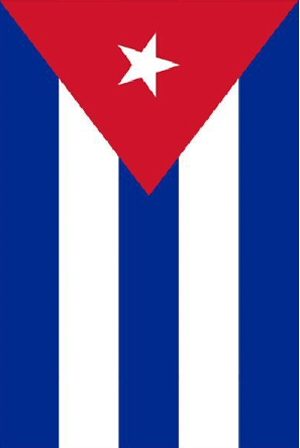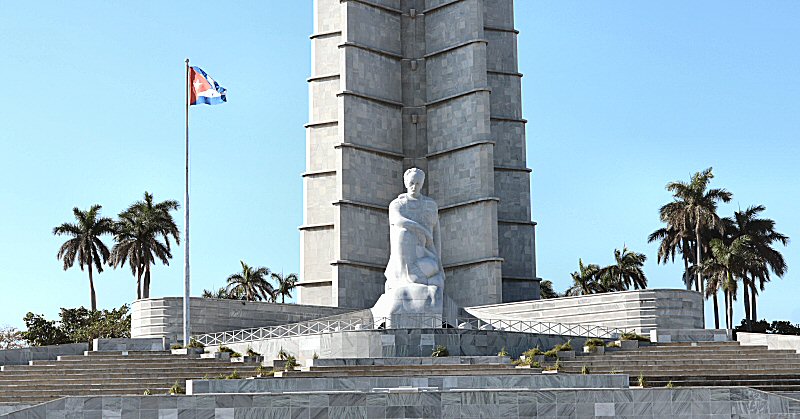
The Memorial a José Martí is the tallest structure around the Plaza de la Revolución.


The Memorial a José Martí is Havana's
tallest structure, and it is the largest monument dedicated
to a writer on the world. The whole memorial is dedicated to
the tireless fighter of all forms of injustice, to a man
that didn't hesitate to give his life on the battlefield for
Cuba’s fight for independence from Spain in the late 1800s.
HISTORY
In 1933 the provisional government, headed
by Dr. Carlos Mendieta, issued a decree to erect a monument
in the city dedicated to the memory of José Martí. A
commission was created that would decide about the place of
the monument and to organize a contest to choose the best
project. The contest rules were declared by the Academia Nacional de Artes y Letras (National Academy of Arts and
Letters) in 1935.
In 1937 the President Federico Laredo Brú
issued a presidential decree, according which a National
Commission for the Monument of José Martí was created,
headed by the Secretary of Defense Rafael Montalvo, and made
a call to the public employees and the members of the armed
forces to offer one day of their salaries for the
achievement of the project.
Initially, there was a great difference in
the
opinions about the place where the monument would be
erected. Some advocated the Plaza de la Fraternedidad,
whereas others pointed at the Parque Central, where a statue
of José Martí was already present since 2005. Colonel
Fulgencio Batista proposed an existing square at the
intersection of the G street (Avenida de los Presidentes)
and the Malecón. It was the prestigious historian Emilio
Roig de Leuchsenring (1989-1964) that insisted on the Plaza
Cívica, on the Loma de los Catalanes (Hill of the
Catalans), a place that was already conceived as the future
geographical center by the French landscape architect Jean
Claude Nicolas Forestier (1861-1930) that carried out many
urban works in Cuba like Parque de la Fraternidad, Plaza de
la Catedral, Paseo de Martí, El Capitolio etc. during his
visits to Cuba from 1925 to 1939. Loma de los Catalanes had
the strategic advantage of being located between the main
urbanizations of the time like Vedado, Cerro, Marianao and
Centro Habana. Emilio Roig de Leuchsenring was of the
opinion that the structure should have a monumental type
with the surrounding square, the Plaza Cívica, more than a
statue alone. In 1937 the commission decided to build the
monument on the Plaza Cívica, as it was a place that met the
conditions at the best.
The rules of the contest were published in
the daily press and in an official report of the commission,
written in several languages. The first Pan-American
competition for the monument’s design was held in 1938;
however, it had to be repeated three times more until the
last one in 1943, as none of the projects was good enough to
award the prize. On the other hand, every contest gave the
opportunity to enhance the project, because initially nobody
had a clear opinion about the magnitude and type of the
monument. In some projects the monument was designed as a
temple, in some as a vertical statue, in the others as a
sculptural set. After the fourth and final contest in that
only the previously selected projects were accepted, the
commission declared the project of the architect Aquiles
Maza and the sculptor Juan José Sicre with the title Templo
Martiano (or Templo de Americas) as the first prize. It was
also decided to propose to the project winners to discuss on
the change of the sculpture in the project with the
sculpture designed by Esteban Betancourt before.
The second prize was awarded to the project of the architect and engineer Evelio Govantes Fuertes and the architect and sculptor Félix Cabarrocas Ayala in that a monumental library was conceived. This library stands on one side of the Plaza de la Revolución with the name Biblioteca Nacional José Martí (National Library José Martí) today.
The third prize has gone to the project,
created by a group of architects, including Raoul Otero de
Galarraga, Enrique Luis Varela and Professor Jean Labatut.
In this project the construction was designed in the form of
a five-pointed star as the symbol of freedom and
independence.
Even though, the project was ready, and
the necessary fund was raised, nothing was done concerning
the construction of the monument from 1943 to 1952, a period
that coincide with the first presidential term of Fulgencio
Batista (1940-1944) and the successive President Ramôn Grau
San Martín (1944-1948). The old hermitage, the Ermita
de los Catalanes (or Ermita Monserrate, as the Catalans
dedicated the hermitage to their patron Virgin of Monserrat
When Fulgencio Batista took over the
presidency after Carlos Prío Socarrás in 1952, he buckled
down to the project of construction of a monument dedicated
to the memory of José Martí, as he wanted to clean up his
image by such projects that gain sympathy of every section
of the society. He raised the taxes to use the additional
charge on the project of the monument, ordered to print
editions of stamps honoring José Martí that would be sold
and issued a presidential decree, imposing the public
workers to donate their one-day income to finance the
project. At his behest, activities in schools were carried
out to generate funds for the project.
While everybody was expecting that the
project of Aquiles Maza and Juan José Sicre would put into
practice, Fulgencio Batista selected the project that had
come third in the contest. This was not a big surprise, as
Enrique Luis Varela was the Minister of Public Works and
Batista’s personal friend, and Batista had assigned him as
the coordinator of the Plaza Plaza Cívica. Later, Enrique
Luis Varela explained that some elements of the other two
prize winner projects would take part in their project, like
the José Martí statue of Sicre and Maza and the monumental
library of Govantes and Cabarrocas.
The area destined for the square around
the monument increased to more than twofold, but during the
expropriation of the land to expand the square, carried out
by the Ministry of Public Works, many inhabitants of the
marginal neighborhood La Pelusa were threatened by the
expropriation of their homes, if they would not pay money.
The abuse was at such a degree that the young lawyer Fidel
Castro assumed the defense of these oppressed people in
1951.
The change in the design of the monument
generated great debate in the public that led to a last
modification of the design, in that the position of the
statue of José Martí that was atop the tower according the
project of Sicre and Maza, was lowered and moved to the base
of the monument.
The construction of the tower started on
the 100th anniversary of José Martí's birth in 1953. The
construction of the tower and the statue of José Martí were
finished during the final days of Batista at the end of
1958, but some exterior detailing remained, so that the
complex could not be completed before 1961. During the
period when the museum inside was closed to the public, the
marble platform in front of the tower was used for different
activities, like large meetings. On the occasion of
the centenary of the fall in combat of José Martí that had
occurred in 1895, it was concluded to put the museum into
service; thus, the museum was inaugurated in 1996.
